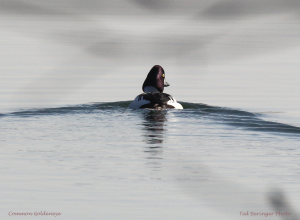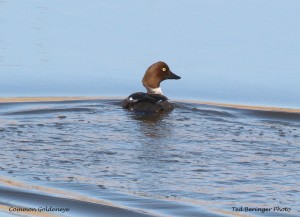Common goldeneye
Common Goldeneye
by Ted Beringer
In North America the Common goldeneye (Bucephala clangula) is a diving duck that winters across the United States but breeds in the boreal forests of Canada. For this reason, mining of tar sands that requires scouring the boreal forest is destroying critical habitat for these birds and many others that breed there. Construction of the XL pipeline intended to transport these tar sands across the United States for export will hasten this loss of habitat.
Description: The female has a milk chocolate brown head above a white neck ring.
Its eyes are pale yellow to white. It has a short, triangular black bill sometimes with a yellow to white tip. Its back, wings, and tail are slate gray. Its flanks, belly, and breast are white.
The male Common goldeneye has a greenish-black head with a dramatic golden-yellow eye as well as a conspicuous round white spot in front of each eye immediately behind its short black triangular bill. Its black back, tail and secondaries plus white flanks are easily apparent on the water.
Habitat: Their breeding habitat in North America is the boreal coniferous forest in North America with nearby lakes, rivers and bogs that have enough irregular shoreline to provide protective brood shelter. They nest in cavities in large trees especially in open-top or “bucket” cavities. They also use natural tree cavities created by broken limbs or tree cavities created by pileated woodpeckers and black woodpeckers.
Diet: In the summer they prefer ponds without fish that compete for insects or even prey on their ducklings as in the case of Northern pike. The Common goldeneye forages underwater consuming mostly crustaceans (crayfish, crabs, shrimps & amphipods) and aquatic insects (naiads of dragonflies & damselflies) as well as some mollusks (especially blue mussel). They will also consume small fishes and their eggs, marine worms, and frogs. They enjoy aquatic plants like pondweeds, spatterdock, bulrush, and wild celery.
The common goldeneye is one of the species to which the Agreement on the Conservation of African-Eurasian Migratory Waterbirds (AEWA) applies. However, both breeding and winter habitat of these birds has been degraded by clearance and pollution. For further information about the Common goldeneye, visit the following excellent websites:
http://www.nwf.org/~/media/PDFs/Global-Warming/2014/Tar-Sands-Fact-Sheet_Pelly-Amendment-UPDATE.pdf


